The State of Event Marketing in 2025 So Far
How 200 B2B companies are using events to drive pipeline and what the data reveals about channel effectiveness
.png)
Introduction
Events have always been the paradox of B2B marketing. They're expensive, hard to measure, and logistically complex — but one perfectly-timed webinar or conversation at a booth can unlock that elusive seven-figure deal your VP of Sales has been vying for. In 2025, with tighter budgets and higher pipeline targets, the question isn't whether events work. It's which events work, for whom, and when.
Here at HockeyStack, we analyzed event marketing performance across 198 B2B SaaS companies from our customer base, examining over 2.6 million deals with an event touchpoint from January 2024 through September 2025. We tracked how live and virtual events performed across different company segments and seasonal patterns.
Methodology & Definitions
Event Types:
- Live Events: In-person conferences, trade shows, field events, roadshows, and executive dinners
- Virtual Events: Webinars, virtual conferences, online summits, and digital roundtables
- Other: All non-event channels including digital advertising, content marketing, SEO, email, outbound, and partner channels
Deal Stages:
- Deals Created: Any opportunity entered into CRM, regardless of source or quality
- Deals Qualified: Opportunities that met company-specific qualification criteria. If the organizations uses two levels of qualification (e.g. MQL and SQL), the second level of qualification was used (e.g. SQL)
- Closed Won: Completed deals with signed contracts and recognized revenue
Company Segments:
- SMB: 1-99 employees
- Mid-Market: 100-999 employees
- Enterprise: 1000+ employees
The Dataset
- Sample Size: 198 B2B SaaS companies
- Time Period: January 2024 - September 2025 (21 months)
- Total Deals Analyzed: 2,642,337
- Regions: North America and Europe primarily
Attribution Model
For this benchmark report, we used linear attribution: distributing equal credit across all marketing touchpoints. With 198 companies each having unique sales cycles, channel mixes, and go-to-market strategies, linear attribution provides the following advantages:
- Neutrality: Doesn't assume where events sit in the funnel
- Comparability: Normalizes across different marketing strategies
- Fairness: Recognizes events as mid-funnel accelerators, not just first/last touch
- Standardization: Creates apples-to-apples comparison across PLG to enterprise motions
Key Questions This Report Answers:
- Do events actually drive better pipeline quality than other channels?
- How do Live Events and Virtual Events compare in driving qualified opportunities and closed deals?
- Which company segments (Enterprise, Mid-Market, SMB) respond best to different event types?
- What seasonal patterns emerge in event effectiveness throughout the year?
Part I: Channel Performance: The Quality vs. Quantity Trade-off
The Volume Reality Check
Looking at raw deal creation numbers, the takeaway seems clear. Compared to other channels (1.6 million deals created), Live Events (64,240 deals created) and Virtual Events (42,987 deals created) appear to be niche players, responsible in totality for ~6.5% of closed deals.
.png)
As every marketer knows, however, volume is only part of the story. Success can be measured in infinite ways: conversion rates through the funnel, CAC efficiency, or even deal quality and velocity. A channel producing fewer deals may still punch above its weight if those opportunities move faster, close more, or churn less frequently.
In fact, our prior HockeyStack Labs analyses have shown that event-sourced opportunities tend to have higher ACVs and shorter sales cycles compared to digital-first channels. So, while events don’t flood the top of the funnel, they often deliver outsized business impact, driving the kind of high-quality pipeline most revenue teams are chasing.
For example, our prior HockeyStack Lab Reports have shown that event-sourced opportunities often have higher ACVs and shorter sales cycles compared to digital-first channels. So, while events may not flood the top of the funnel, they can often deliver outsized business impact, driving the kind of high-quality pipeline most revenue teams are chasing.
Conversion Efficiency
When we track conversion rates through the funnel in 2025, events start to show their true strength. Virtual Events convert from creation to qualified stage at 6.41%, the highest efficiency across all channels. Live Events follow closely at 5.50%, while all other channels average 4.82%—underscoring that even with lower volume, event-sourced deals move through the early funnel more efficiently than most.
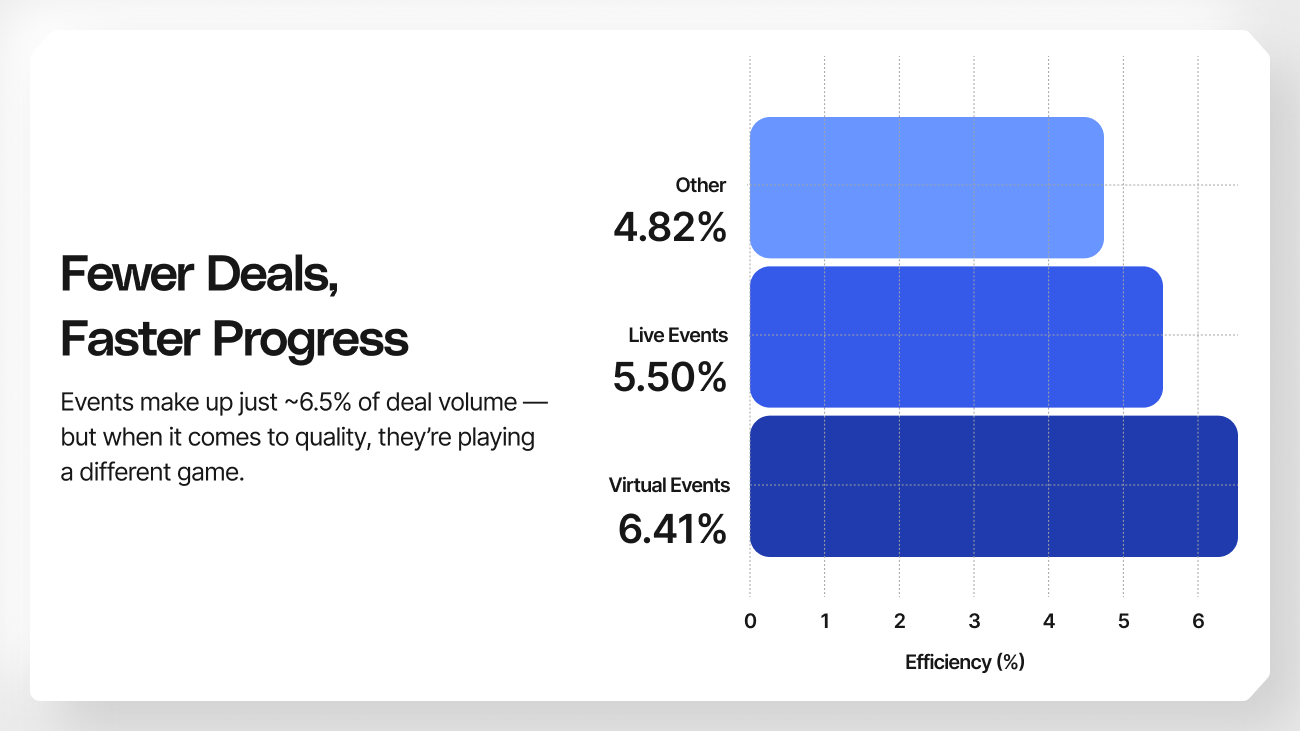
Virtual Events, perhaps surprisingly, convert to qualified opportunities 33% more efficiently than other channels, despite representing less than 3% of total volume. This efficiency gap may come from the intent level of attendees. Unlike paid channels that often attract low-commitment form-fills, event participants—especially in B2B—tend to be actively researching solutions or already aware of their problem.
Live Events, meanwhile, are slightly less efficient than virtual events at this early stage. However, that doesn’t tell the full story. Live and virtual events both tend to underperform in attribution-based analyses because of their smaller volumes, longer deal cycles, and offline engagement touchpoints that attribution tools often miss. Later in this report, we’ll conduct an incrementality (lift) analysis to surface the true downstream impact events have on pipeline and revenue, beyond what attribution alone can measure.
Why We’re Focusing on Early-Stage Conversion
You might notice we’re highlighting Created-to-Qualified conversion rather than Qualified-to-Closed-Won. That’s intentional. Deal velocity and close performance can be heavily influenced by external factors like seasonality, budget timing, company size, and even sales coverage. This makes it difficult to isolate the impact of channel quality alone.
Early-stage conversion, however, is a more reliable measure of channel intent and lead quality. It reflects how effectively a channel brings in qualified opportunities before sales influence takes over. In other words: this is the clearest lens through which we can see marketing’s true performance, without the noise of later-stage variability.
Key Insight: Events Are Pipeline Accelerators
Despite smaller deal counts, both Live and Virtual Events far outperform the typical B2B average of 5–10% conversion from created to qualified. This suggests that event-driven leads aren’t just higher quality. They’re also further along in their buying journey and more committed to finding solutions.
While digital-first channels deliver scale, events continue to deliver substance: fewer, higher-value opportunities that move through the funnel with intent and momentum.
Part II: Monthly Patterns: Timing Is Everything
While overall volume paints events as niche contributors, the Created-to-Closed Won monthly data in 2025 shows volatility, seasonality, and sharp efficiency differences between Live Events, Virtual Events, and all other channels.
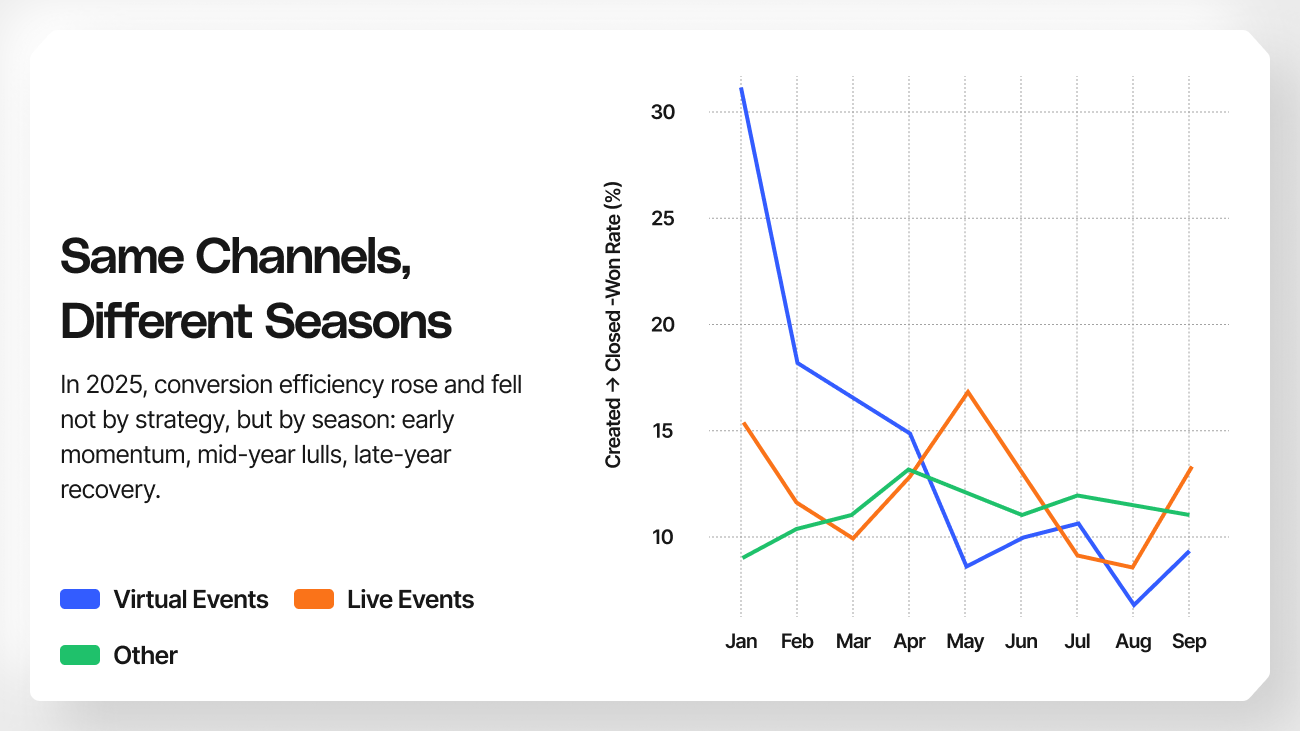
Overall Trend: Early-Year Momentum
Across events, the first half of 2025 shows stronger conversion performance than the latter half. Both Live and Virtual Events peaked between January and May, suggesting that deals created during Q1 and early Q2 benefited from fiscal-year kickoffs, new budgets, and concentrated go-to-market activity.
After May, conversion rates across every category decline, stabilizing around mid-year averages. This mirrors a pattern seen in previous HockeyStack Labs data: early-year marketing tends to generate faster-moving, higher-intent opportunities, while deals created later in the year face longer cycles and heavier competition for attention.
Live Events: Consistent, Moderate Performance with Mid-Year Dips
Live Events maintained conversion rates between 8% and 17%, averaging 12.1% for the year-to-date period.
- Peak: May (16.92%) — coinciding with event season in many markets, when in-person conferences and field activations are at their highest.
- Lowest Point: August (8.12%) — typical of post-summer lulls, when decision-making slows.
- Rebound: September (13.33%) shows recovery, possibly from deals initiated during summer but closing early Q4.
The data suggests that Live Events create steady, relationship-driven deal flow that sustains above-average close rates compared to “Other” channels. Their cyclical nature reflects the timing of major conferences and in-person engagements, with a strong close pattern following major event months.
However, their mid-year volatility — dropping nearly 9 percentage points between May and August — highlights their dependency on event timing and follow-up execution.
Virtual Events: A Story of Early-Year Spikes and Rapid Decline
Virtual Events show the most dramatic swings of all.
- Peak: January (31.6%) — an outlier and the highest single-month close rate across all channels.
- Decline: Sharp drop from 31.6% in January to just 8.23% by May, a 74% decrease in efficiency.
- Stabilization: From June onward, conversion hovers between 8–11%.
At first glance, the January spike looks like an extraordinary win for virtual engagement—but it’s far more likely the result of data and attribution timing than a genuine performance surge. Because this dataset uses linear attribution, virtual event touchpoints from late Q4 2024 are still receiving partial credit for deals that closed in early January. That, combined with CRM reconciliation cycles, where revenue teams clean up and finalize prior-year opportunities, can artificially inflate early-year conversion metrics.
In short: January’s outlier performance is more reflective of when deals were recorded than how effectively virtual events performed. It’s a reminder that attribution, especially in multi-touch, long-cycle channels like events, often misrepresents timing and true impact.
Beyond that anomaly, the downward trend throughout the first half of the year is still notable. This steep decline likely stems from a combination of:
- Seasonality and attention cycles: Early in the year, virtual events benefit from fresh budgets and post-holiday momentum. Engagement typically softens by mid-year as buyers shift focus to in-person events.
- Deal quality dilution: The initial wave of highly motivated buyers in Q1 gives way to lower-intent audiences later in the year.
- Follow-up inconsistency: Virtual events often lack the personalized, relationship-driven follow-up that helps sustain deal progression in live settings.
Despite their volatility, Virtual Events still averaged 14.2% Created-to-Closed Won for the first half of 2025, nearly 40% higher than “Other” channels during the same period.
Ultimately, the January anomaly underscores a larger truth: attribution alone can distort how we interpret event performance. Later in this report, we’ll run a lift (incrementality) analysis to uncover how much real, causal impact Virtual and Live Events have on pipeline and revenue, beyond what attribution can capture.
Other Channels: Slow and Steady Baseline
The “Other” category remains the baseline of stability, ranging between 9–13% throughout the year with little fluctuation.
This consistency reflects the aggregated nature of the category (paid, organic, referral, etc.) — a blend of always-on motion rather than campaign-based peaks. These channels show less short-term volatility but also fewer efficiency spikes, serving as the backbone of pipeline creation rather than the accelerant.
Cross-Channel Takeaways
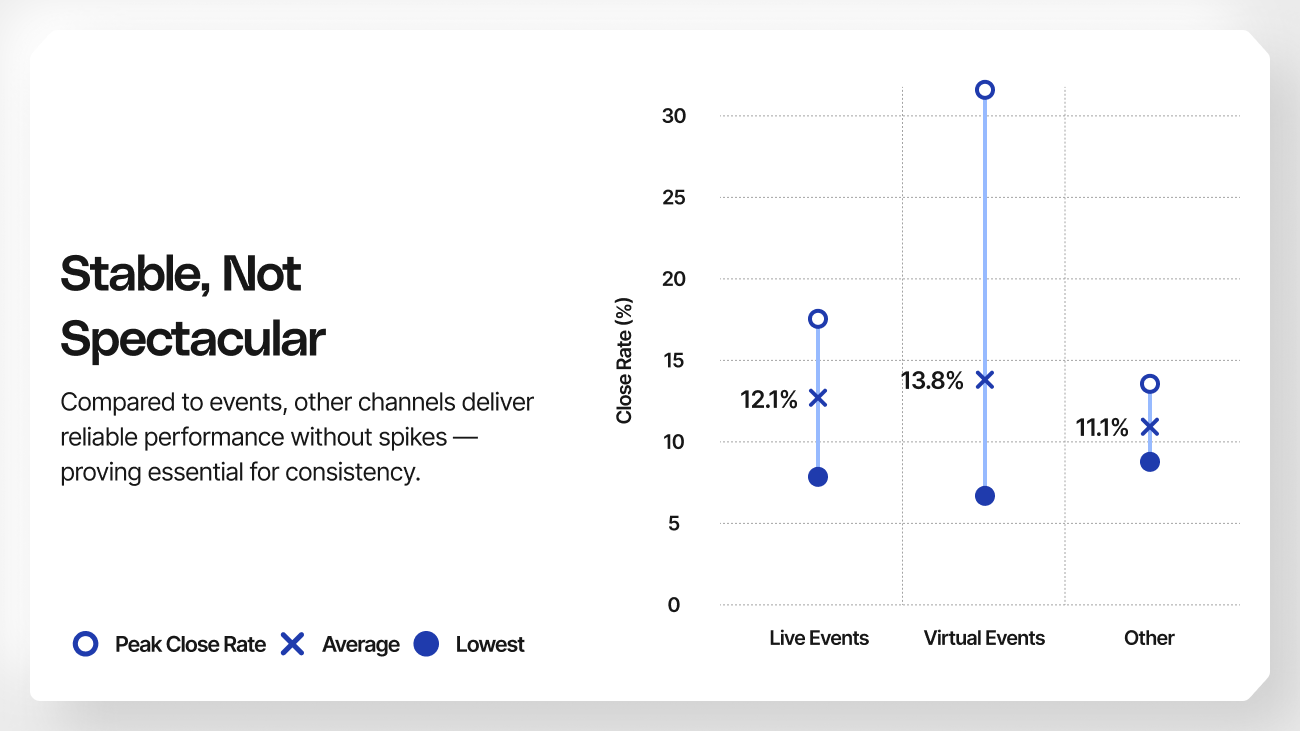
Event-driven deals remain some of the highest-quality opportunities in the B2B funnel, but their performance varies sharply based on timing, channel type, and post-event execution. Live Events bring steadiness and relationship depth with Virtual Events deliver spikes of efficiency that can fade without sustained engagement. However, to fully understand how events influence revenue, we’ll need to move beyond attribution and quantify their incremental impact.
Conversions by Company Segment
When looking at deal progression from Created to Qualified, company size plays a major role in how effectively vendors convert event-sourced pipeline.
SMB vendors show the strongest early-stage efficiency across all event types—especially with Live Events (11%), far outperforming their Mid-Market and Enterprise peers. Smaller organizations often have tighter alignment between marketing and sales, allowing for faster follow-up and more personalized engagement. Perhaps more importantly, their smaller, more focused audiences may also make it easier to identify and qualify true intent, driving higher conversion rates even with limited scale.
Enterprise vendors perform best with Virtual Events (4%), suggesting that digital engagement models work more effectively for larger teams with complex buyer journeys. These companies typically operate with longer sales cycles and distributed decision-making, making virtual environments a more practical and scalable way to generate and nurture qualified opportunities.
Mid-Market vendors consistently underperform across all event types: 2–3% conversion rates compared to stronger performance from both smaller and larger companies. This middle segment may be facing a dual challenge: not yet operating with the process maturity of enterprise teams, but lacking the agility and speed of smaller vendors. Their event programs may be broad enough to capture interest but not yet refined enough in targeting or follow-up to convert efficiently.

Key takeaway:
The data highlights a clear operational pattern: smaller vendors convert more efficiently, large enterprises convert more predictably, and mid-market vendors struggle most with event-driven qualification. Agility and follow-up precision appear to outweigh budget size in driving event ROI.
Part III: Incremental Impact of Events
Attribution tells us which touchpoints were present in a deal. Lift tells us what actually changed because of them.
Why Lift Matters for Events
Traditional attribution, whether linear, first-touch, or last-touch, assigns credit to channels that appear in a buyer’s journey. It shows correlation, not causation. For event-driven activity, this approach often over- or underestimates performance because events influence deals indirectly or later in the cycle.
Lift (incrementality) solves for this. Lift measures the causal effect of a channel by comparing what actually happened to what would have happened without that channel’s influence. A positive lift indicates that deals exposed to the channel were more likely to close; a negative lift means the channel didn’t drive incremental improvement or may have even hurt performance.
For event analysis, lift provides a clearer view of true impact on revenue, stripping out timing noise, attribution overlap, and delayed conversions that skew linear models. Read more about lift, and how it’s calculated, here.
Impact of Events on Opportunity Creation
Across the dataset, both Virtual and Live Events show significantly higher incremental impact on opportunity creation than “Other” channels. In plain terms, when a company runs or participates in an event, the likelihood of generating a new opportunity increases — sometimes dramatically — compared to a similar company that doesn’t.
At a glance, Virtual Events lead slightly in average lift, suggesting that they can scale broader reach into tangible pipeline impact. But Live Events still deliver a strong, reliable median, proving that even when attendance is smaller, the quality of opportunities created remains high.

However, the more interesting story emerges when you break it down by the type of company hosting the event.
By Company Segment: Different Companies, Different Strengths
Enterprise hosts see enormous lift from Virtual Events (mean +20.1) — by far the highest across all segments. This makes sense: large companies have the resources to produce sophisticated digital experiences that attract broad, high-intent audiences. Their brand equity alone draws participation, and virtual formats make it easier for enterprise teams to reach hundreds (or thousands) of accounts simultaneously without the geographic or logistical constraints of in-person events.
SMB hosts, by contrast, excel with Live Events (mean +18.9, median +12.5). Smaller companies tend to thrive in high-touch environments where deals are built on personal relationships, credibility, and trust. For SMBs, an in-person event is not just a marketing play — it’s often the single most direct path to building meaningful customer relationships and driving pipeline momentum.
Mid-Market companies sit somewhere between those extremes. Their results are steady, with moderate lift across both Live and Virtual Events, but no breakout channel. This middle-tier pattern may reflect growing pains: enough budget to experiment, but not yet the scale or precision to maximize either approach.
What’s consistent across all groups is that “Other” channels—things like content, paid, or email—rarely generate the same incremental motion. They sustain momentum but don’t create new inflection points in the way events do.
Closed-Won Lift: Where the Impact Becomes Undeniable
Opportunity creation tells us events get the ball rolling. Closed-won lift shows whether those opportunities actually convert.
Here, the signal strengthens. Both Virtual and Live Events demonstrate powerful, measurable effects on revenue conversion, well beyond the levels seen in other channels.
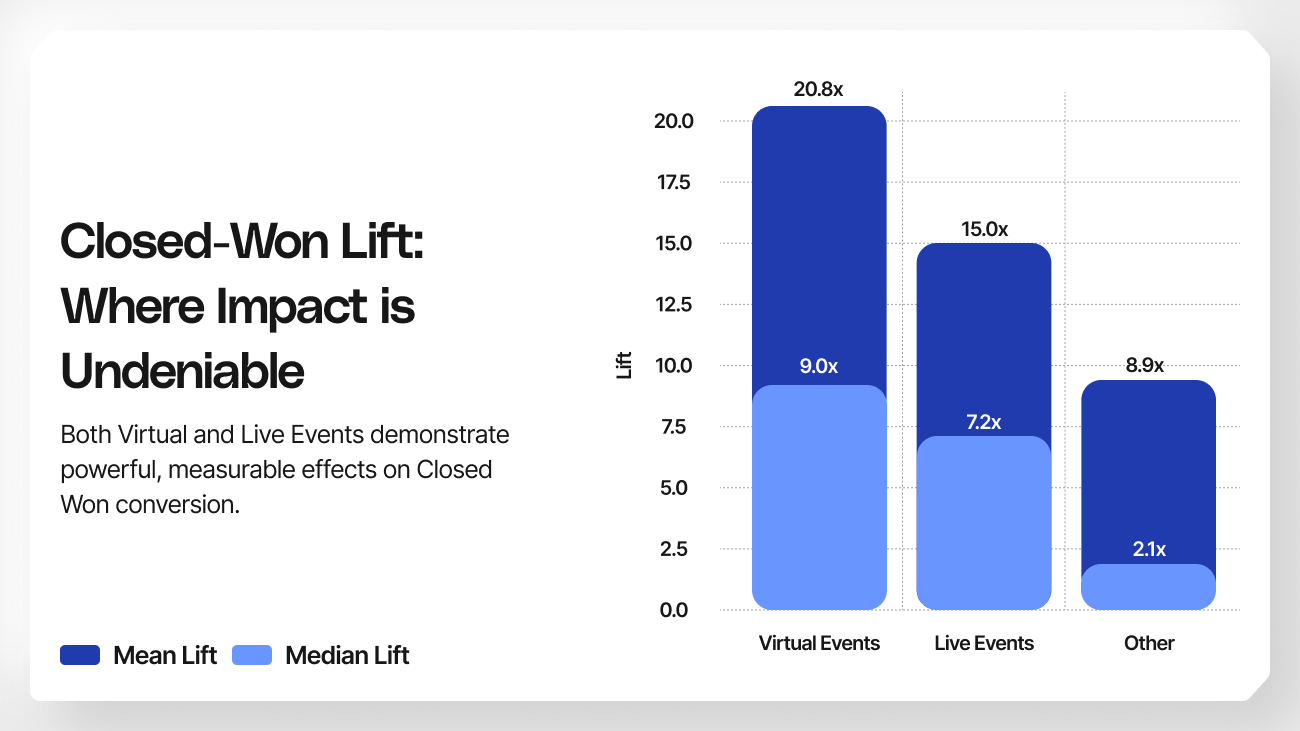
And once again, performance varies dramatically depending on who’s running the program.
Enterprise-hosted Virtual Events deliver the strongest impact of any combination in this study: an average 38.6x lift in closed-won rates. This suggests that for large B2B companies, virtual engagement isn’t just a top-of-funnel tactic, it’s a revenue engine. With multiple stakeholders and long cycles, virtual events enable scalable, controlled nurturing across distributed buying committees.
SMB Live Events again emerge as the breakout performer on the opposite end of the spectrum wirh a mean 33.2x impact. The data reinforces what every field marketer already suspects: for smaller companies, there’s no substitute for face-to-face connection. Whether it’s a local dinner, a hands-on workshop, or a co-hosted meetup, the conversion power of personal engagement is undeniable.
Mid-Market hosts show positive, steady lift in both channels but without the same spikes. This likely reflects structural realities — mid-sized companies often have smaller field teams than enterprise peers, and their virtual programs lack the scale to match the reach of larger brands. Their event impact is healthy, but not yet optimized.
Meanwhile, “Other” channels maintain a modest baseline of 7–11 lift points. They remain essential to demand generation, but compared to events, their incremental effect is limited.
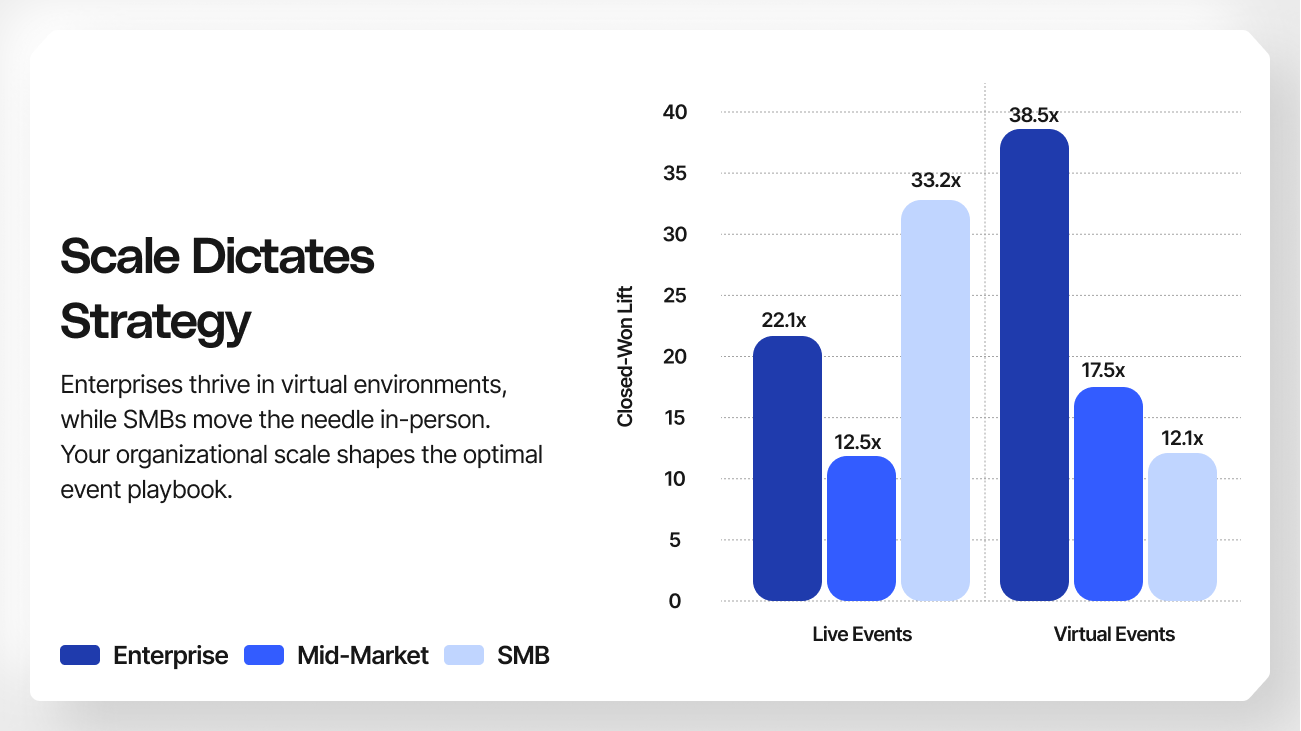
Why Lift Changes the Way We Think About Events
Lift reframes the conversation from “What got credit?” to “What truly moved revenue?”
For events, this distinction matters more than for any other channel. Attribution often undervalues events because of their long-tail influence and offline touchpoints, while lift captures the full downstream effect—including the trust, credibility, and relationship momentum they create.
The takeaway is clear:
- Virtual Events are the most scalable growth lever for large companies, driving massive incremental gains across both pipeline and revenue.
- Live Events remain the most potent driver for smaller companies, proving that personal connection still outperforms production value when resources are limited.
- Mid-Market companies benefit from a balanced strategy but have room to specialize, doubling down on whichever channel aligns best with their maturity and audience engagement model.
Ultimately, lift reveals what attribution can’t: that events don’t just touch deals. They create, accelerate, and close them.
Conclusion: Rethinking Event Strategy for 2026
If 2024 was the year of “getting back to events,” then 2025 became the year of proving their value. The data is no longer anecdotal. Events — whether live or virtual — are not just brand exercises or mid-funnel accelerators; they’re measurable revenue drivers. But their impact isn’t uniform. It depends on who is hosting, what type of event is run, and how it’s followed up.
Across nearly 200 B2B SaaS companies and 2.6 million deals, the following takeaways emerged:
- Events drive quality, not quantity.
- Even though events represent only ~6% of total deal volume, their efficiency and downstream impact far exceed other channels. Both live and virtual formats outperform the B2B average at every stage of the funnel — especially when measured through lift rather than attribution.
- Virtual Events are the enterprise growth engine.
- For large organizations, virtual programs aren’t only scalable. They’re also revenue-producing machines. With a 38.6x lift in closed-won deals, enterprise virtual events clearly deliver reach, consistency, and measurable ROI. The key for 2026 will be doubling down on content-led virtual engagement that connects multiple stakeholders and ties directly to pipeline progression.
- Live Events are SMB’s conversion secret weapon.
- In-person experiences continue to dominate for smaller hosts, showing 33x incremental lift in closed deals. When resources are limited, smaller companies win through intimacy —dinners, workshops, and partner co-hosted gatherings, where authenticity drives trust. SMBs should trade quantity for quality and focus on fewer, high-impact activations.
- Mid-Market companies need sharper focus.
- Mid-Market hosts show consistent but underoptimized lift across formats. Their opportunity is strategic: specialize. Lean into virtual if efficiency and scale matter most, or live events if brand depth and relationships are key. Straddling both with equal weight is likely diluting returns.
- Lift should become the new event KPI.
- Attribution will always matter for visibility, but incrementality tells the truth. As teams plan 2026 budgets, lift analysis should guide where to spend, scale back, or experiment. It’s not just about tracking who attended — it’s about quantifying what changed because they did.
In 2025, events once again proved their worth — not through anecdotes, but through data. They may not generate the most deals, but they generate the ones that matter. Whether virtual or live, small or large, events remain one of the few B2B channels that both humanize and scale.
As we move into 2026, the most successful marketing teams won’t be those running the most events. They’ll be the ones measuring the right things — the teams that understand not just where events fit in the funnel, but how much incremental revenue they truly create once they’re there.

